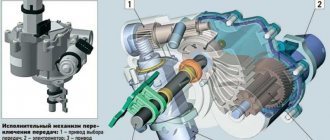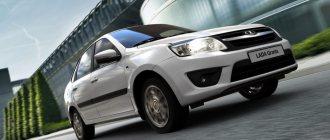Lada Vesta Exclusive is the maximum and most armed model of the domestic VAZ automobile industry. Under the hood of the version there is a 1.8 liter and 122 liter engine. s., and this is a worthy reason to get behind the wheel of a car and take a test drive on domestic roads.
Lada Vesta Exclusive The differences from other modifications of the Lada Vesta Exclusive are not limited to the presence of a powerful engine. This model has its own distinctive features in all directions - interior, exterior, performance, driving characteristics.
Potential consumers are primarily attracted by a 1.8 liter engine with a power of 122 hp. With. The driver is offered manual and automatic transmissions.
The standard engines of VAZ cars are 1.6 liters and 106 liters. With. A car with a manual transmission is a cheaper option (in comparison with the same, but robotic version). The transmission installed in the model has long been known to consumers - it is a standard 5-speed transmission.
Interior and exterior
It is not difficult to recognize an exclusive model against the background of its standard counterpart. The model has its own distinctive external qualities:
- chrome body trim;
- exclusive door sill trims;
- spoiler;
- 17-inch wheels with a unique design;
- a nameplate indicating the version name.
The manufacturer also offers this model in beige metallic – “Carthage”. The dimensions of the exclusive version are identical to those of the base model. The machine is:
- 4410 mm – length;
- 1497 mm – height;
- 1764 mm – width;
- 480 l – luggage compartment;
- 178 mm – ground clearance (clearance).
The machine has a modern, stylish design. High ground clearance and large wheels will come in handy when driving off-road. The car is spacious enough to comfortably fit 5 people.
There is plenty of legroom in the back row. However, very tall passengers run the risk of resting their heads on the ceiling. The interior is trimmed with leather and Alcantara. Available options include material in black and beige.
The model uses wear-resistant materials. The leather version features a steering wheel with stitching, the color of which can be chosen optionally, as well as the color of the decorative seam in the seats. The interior has a glossy black finish on some elements. All materials are pleasant to the touch. The floors are decorated with original textile rugs. The pedals have metal covers.
The interior features exclusive LED atmospheric suspension for the door pockets, driver's foot area, central tunnel, and front passenger.
Belarusian test drive Lada Vesta
One of the very first Lada Vestas to appear in Belarus was given over to journalists from local automobile publications. Another video review after six months of active use of the car shows what comments appeared on this car.
Appearance of the car
The video shows a white sedan, looking at which you can’t tell that it was subjected to different test drives every day for six months. During this time the car covered 13 thousand km. No external damage was found. We lift the hood - but everything is clean there, as if the engine’s mileage was no more than 500 km. One small “jamb” was nevertheless noticed - the soundproofing cover slightly rubbed the handset.
The salon has retained its original interior. The seats are also firm and comfortable. The plastic of the front panel has retained its appearance. The car radio and air conditioning buttons work properly. No abrasions are visible.
Technical condition of the car
The video test of the Belarusian Lada Vesta revealed some technical comments:
- The turn signal does not always turn off after completing the maneuver;
- the engine ignition occurs with some delay, perhaps the reason is a problem with the starter;
- When driving at low engine speeds, an incomprehensible sound appears that cannot be diagnosed in any way.
The Belarusian prototype left behind pleasant emotions. The test drive proved that the AvtoVAZ sedan is quite reliable even after such active use.
Control
The driver's seat is comfortable. You can set it according to your needs. The steering wheel pleases with clear feedback. Vesta reacts even to small deviations, but not abruptly, which is undoubtedly a plus. While driving, the sedan seems to “read” the driver’s thoughts and follows where it needs to go. No burdensome heaviness, no stickiness. I like the live response.
The car holds a straight line perfectly at high speeds. There are also no complaints about the brakes. Effort, movement - everything is clear and understandable. The Lada Vesta slows down quite adequately. In critical situations, the emergency lights turn on independently, warning the passengers behind.
It turns well, the chassis works great, there is practically no roll. The developers didn't waste their time in vain. Finishing, polishing driving properties - everything is excellent.
The programs are not “numbered”
For some reason, the large LADA inscription on the trunk lid causes active rejection among motorists. It is the discharge of letters that haunts people. But to me it doesn’t seem... or at all irrelevant. In the end, I think these letters can be carefully removed. Much more interesting is the design of the lid drive. Firstly, it does not have an opening button. You can unlock it either by pressing a button in the car or on the key fob, or mechanically with a key. Secondly, if you lift it low and let it go, it will immediately lower and lock itself again. It is imperative to raise it to a vertical level, in this position it remains stable. Of course, it would be better to adjust the drive by installing the ends of the springs (you will immediately see them when you open the cover) into the “fourth” holes of the adjuster strips instead of the standard “thirds”. But this will require a lot of effort.
Here's your first minus. I’m not even talking about the fact that the semicircular hinges of the lid, when it is closed, protrude significantly into the trunk. However, which of the “state employees” can boast of a more compact mechanism? No one. So in this LADA Vesta is neither ahead nor behind.
From the hood the car is much prettier than from the back and sides. He's beautiful! The curved LED strips in the headlights attract attention. The signature rook emblem has become larger and more stylish. But again, let's open the hood. Why is the engine compartment covered in dirt during the not so long total mileage of the test car - only about 5,000 kilometers? Yes, because something was missing to install an additional hood seal, so all the dirt flies into the gap. Either they spared money, or no one has ever seen how craftsmen themselves protect engine compartments from dirt using tubular window seals. And the Vesta engine will also be insulated, while speaking about this “product” not too flatteringly. Other companies also do not seal engine compartments, but at least they try, they think...
The interior is filled with a variety of hard plastics, but that’s not a problem. It is difficult to expect the interior of an inexpensive car to be decorated with more noble materials. Moreover, everything is arranged successfully and conveniently, it has its own style. In addition, the dashboard does not look “empty”, as on the Xray model. There are elements everywhere that attract attention and evoke positive emotions. But there are also “disadvantages”.
The first is that you have to squeeze between the steering wheel and the seat. The “gap” here is very small and it will not be possible to raise the steering wheel higher or set the seat lower. If you move away from the steering wheel, you will have to reach for it. As the driver's seat increases in height, it moves closer to the steering wheel, and as it decreases, it moves away from it. Sitting “on the floor” is not the best option: visibility deteriorates. The presence of a lumbar support adjustment lever is a definite plus.
The second drawback is that the AMT selector moves very easily. Sitting behind the wheel in winter clothes, it is not difficult to imperceptibly “shift” it, for example, from position A to N. Next are the cup holders under the center console. They are shallow, so dishes with drinks do not hold in them.
The devices have an interesting design. I would just make them a little larger, then their beauty would be more noticeable. And the “digits” of the on-board computer would become more readable. Although even in this form it looks much better than the BC in LADA Xray. But, while driving a crossover, the driver constantly sees which stage the AMT has chosen, or he himself, if he has taken the gear shifting process in hand. But in Vesta this is not visible not only in automatic mode, but also in manual mode. An arrow recommending upshifting appears on the dashboard, but it is not clear what level it recommends. If you haven’t started counting the gears from the start, then while driving you will never guess which one you are driving.
There are no buttons on the steering wheel in the test car; this is the Comfort package. It also has electric windows only in the front doors, and archaic “oars” in the rear. But on the flanks of the rear sofa cushion there are small recesses for small items. And the width of the cabin at the back is decent: 134 cm. The front is not much larger – 138 cm. The legroom when sitting “behind me” is 30 cm, a good indicator!
The backrest parts are folded in a 1:2 ratio. No, the trunk of the Vesta is quite decent: 480 liters. Its floor length is 95 cm, the opening is 45 cm, the loading height is small, only 71 cm. The twenty-centimeter rear “side” is, unfortunately, inevitable: it is necessary to increase the rigidity of the body. But the car will not please you with its cargo transportation capabilities. The opening from the body to the trunk is small. So, I was unable to place a standard package of insulation containing 12 sheets half in the “hold” and half in the cabin. Only a stack of eight sheets passed through the opening (this can be seen in our photo). Vesta is equipped with a full-size spare wheel located inside the trunk. Under a false floor? No, this is not a false floor, but simply a compacted sheet of upholstery, not even attached to the hardboard. The owner would be better off making a harder raised floor on his own, since the fabric may wear out with frequent transportation of cargo.
Engine and ride quality
The most delicious thing about the model is the new 1.8 liter engine. The increase in power feels good. This model can be successfully used in city traffic. This engine pulls well at low speeds, but you can truly appreciate the full power of the model only after 3,000 rpm and, preferably, on a country road.
The manual version accelerates somewhat more actively than the robot. The clarity of operation, the selectivity of the device - this is all excellent. It is worth noting that at high speed the motor operates normally, relatively quietly, without straining the ears.
The stabilization system sometimes chokes the engine when the wheels slip. It will not be possible to eliminate this completely by turning it off, since if the speed exceeds 50 km/h, it will again begin to make its adjustments.
All the power of the car is clearly visible on the country road. This comes in handy when you need to overtake, and an oncoming car is already visible in the distance.
Review from a car enthusiast
This is a 2022 test drive with a review from novice blogger Alexey, who and his wife decided to test AvtoVAZ’s new product. Having filled out an application at the car dealership, they received at their disposal a brand new Vesta in the Comfort configuration with a 1.6 engine and a manual transmission. After spending about two hours on a visual inspection and a short trip, the couple identified some shortcomings of the car:
- weak acceleration dynamics;
- interior trim with cheap materials;
- noisy engine operation;
- flimsy sun visors.
The pluses included comfortable seats, modern exterior and interior design, and pleasant sound from the speaker system.
In his test drive, Alexey summarizes: the car is closer to foreign competitors, but is inferior to them in terms of build quality and finishing. The car enthusiast hopes that the Lada Vesta Sport, which was presented to the public in 2016, will be able to surpass a regular sedan in many respects.
Below is a video review comparing Vesta with its competitors:
Suspension
Automotive engineers did a good job with the suspension. Now you can ride comfortably even at high speeds without worrying about its integrity. This is especially important with this car, since the model is designed for fast driving.
In terms of design characteristics, the exclusive model copies its standard counterpart. It has the same platform, front independent chassis, and semi-independent rear system.
The energy intensity of the suspension is also at a good level. In terms of smoothness and noise level, the model is not inferior to domestically assembled foreign cars. This is probably the first model that can be compared with foreign cars without any discounts.
Review of the new AvtoVAZ product from a famous video blogger
One of the popular video bloggers, Anton Vorotnikov, known as Avtoman, could not resist his own test drive of the Lada Vesta. The hero of the video review is a red sedan with a robotic gearbox. The first thing a car enthusiast notices is the appearance of the car. A completely new design migrated from the conceptual X-RAY and Vesta, presented back in 2014 at the Moscow exhibition. To everyone's surprise, the production samples retained their original appearance.
Advantages
The author of the video notes many innovations that previous domestic cars did not have:
- silent opening and closing of doors;
- comfortable seating position for the driver, good seat height and tilt adjustment;
- ergonomic location of radio and climate control controls in the cabin;
- stylish design of the center console;
- sufficient space between rows of seats;
- good handling;
- energy-intensive suspension.
Flaws
During the autotest, Anton notes some disadvantages of the AvtoVAZ model:
- significant gaps between body parts;
- insufficient information content of the instrument panel;
- interior trim with cheap plastic;
- poor-quality assembly of interior parts: play in door handles and panels, presence of burrs on plastic parts;
- there is no fixation of the central armrest;
- poor sound insulation;
- drum brakes at the rear;
- delayed gear shifting on the “robot”.
Equipment
If we talk about equipment, it is worth noting that the Lux Multimedia equipment was taken as the basis. Therefore, there are the following options:
- climate control;
- warming up the windshield;
- multimedia system with navigation;
- rear view camera, etc.
As on other models, there is central locking with remote control, steering wheel adjustment in several directions (height, reach), daytime running lights, ERA-GLANAS emergency alert, an impressive safety kit, in particular ABS, brake force distribution, ESC directional stability and others.











